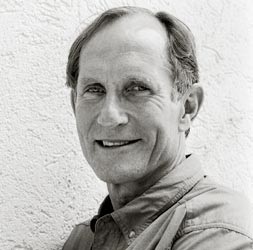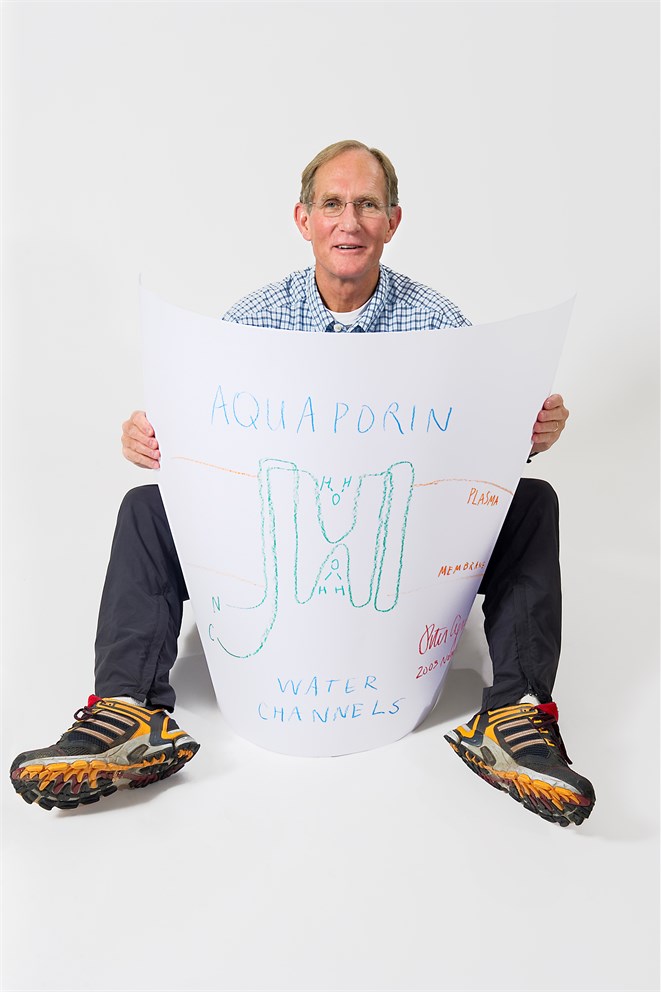Prof. Dr. Peter Agre > CV

Peter Agre was co-recipient of the 2003 Nobel chemistry prize for elucidating how water is transported into and out of the cells of the body. It was long suspected that cell membranes must contain specific water channels, but it was not until 1988 that Agre isolated a membrane protein that he later demonstrated to be the channel. Agre shared the 2003 Nobel with Roderick MacKinnon who used X-ray crystallography to determine the structure and function of ion (salt) channels. Together Agre’s and MacKinnon’s discoveries explain how biological fluids are generated from salt and water.
Agre was born in 1949 in Northfield, Minnesota, 40 miles south of Minneapolis. Like many Minnesotans, he came from ‘Viking’ Norwegian stock. His father was a chemistry professor and a friend of double Nobel laureate, Linus Pauling who was a guest and family hero. Peter attended Theodore Roosevelt High School and was an Eagle Scout, but a school camping trip through Russia brought out a teenage rebellious streak; when his chemistry grade slipped to ‘D’, he quit school in 1967 and continued at night school, while studying Russian during the day. He eventually enrolled at Augsburg College and majored in chemistry. After graduating in 1970, he took a year off to tour Asia and the Middle East before entering Johns Hopkins University School of Medicine, where he became fascinated by biomedical research. He also met his future wife, Mary Macgill at Johns Hopkins. They married in 1975 and have three daughters, a son, and three grandchildren.
After receiving his MD in 1974, Agre trained in internal medicine at Case Western Reserve University Hospitals of Cleveland, and in in haematology and oncology at the University of North Carolina at Chapel Hill. In 1981 Agre returned to Johns Hopkins, becoming an assistant professor in 1983. Working on the Rh blood group antigen, Agre’s team isolated two new membrane proteins of 28 and 30 kDa in red blood cells. After spending 1988–89 on sabbatical to learn DNA technology, Agre decided to explore the 28 kDa protein which was abundant in kidney tubules and related to proteins from diverse sources – bovine lens, fruit fly brains, bacteria, and plants. These clues intrigued Agre, but it was John Parker, his former professor at UNC, who suggested it might be the long sought-after water channel. Together with Greg Preston, Agre performed a simple test by injecting frog eggs with cRNA encoding the 28 kDa protein. Immersing six control eggs in distilled water had no effect, but the eggs expressing 28 kDa protein all “exploded like popcorn.” After reporting their discovery in 1992, the scientists christened the protein ‘aquaporin’ (AQP1). Thirteen aquaporins are now known in humans, but hundreds of aquaporins exist in plants and micro-organisms.
Agre received multiple prizes and awards, was elected member of the National Academy of Sciences in 2000 and chaired the Committee of Human Rights of the National Academies from 2005 - 2007. Since 2018, he has served as Director of the Johns Hopkins Malaria Research Institute. In recognition of his accomplishments as an interdisciplinary researcher and excellent teacher of the next generation of scholars, Agre was named a Bloomberg distinguished Professor in 2014.
Exhibition "Sketches of Science" by Volker Steger - Locations & Dates

By Volker Steger
This is a sportsman in sneakers. He sketches a beautiful picture of his
discovery, the aquaporin channels in the cell membrane.
During the shoot, he gives me a demonstration of some rather cool ski
moves – while holding the sketch with his Nobel discovery!
Er ist ein echter Sportler: Seine Füße stecken in Turnschuhen.
Und er zeichnet ein wunderschönes Bild von seiner Entdeckung,
den Aquaporinkanälen in der Zellmembran.
Während des Fotoshootings demonstriert er mir einige ziemlich
rasante Skibewegungen – während er gleichzeitig die Zeichnung
seiner preisgekrönten Entdeckung in die Kamera hält!
Regulating the Flow
by Adam Smith
You’re looking at a sketch of an aquaporin channel, the route by which water travels across our membranes. Some of our membrane epithelia are pretty impermeable. You can soak in a hot tub for literally hours, and while your toes may get a little squishy you don’t absorb a lot of water. But think of Pavlov’s dog. The dog hears the bell and within seconds its saliva is flowing. There must be a mechanism to allow water to cross membranes that fast when needed, and that mechanism turns out to be the aquaporin family of water channels.
The representation shows a single subunit of the channel, with a pore running through the centre and a space where water (H-O-H) can fit through but nothing else will pass. The notion that there should be channels to explain the movement of water through membranes had been around for a century. But despite many sophisticated experiments that all pointed to the idea that there there must be a proteinaceous pore allowing water to pass through the membranes, none of the logical approaches revealed its identity. There was no culprit.
And then came Peter Agre’s observation of the first aquaporin channel. “We came upon this protein by chance observation” he says. Having purified a new protein, and knowing that it existed in great abundance, Agre checked for water transport, and found it! And while normally in science there are sceptics, his first reports of the findings in 1992 were greeted with virtually no disagreement. Now known to be a family of proteins, the aquaporins allow osmosis to occur across cell membranes (the plasma membranes mentioned in the drawing),water flowing through the channels in the direction of an osmotic gradient. And this happens fast, with thousands of millions of water molecules travelling through a single channel each second!
Agre was awarded his Nobel Prize together with Roderick MacKinnon, who demonstrated what ion channels look like at the atomic level. He describes good scientists as “those people who are total junkies for discovery.” Then he goes on to describe the scientific life: “You don’t know for sure what’s going to happen, and most of the time nothing interesting happens. And once in a while you find something that was totally unforeseen and it’s fascinating, and that happened to us. It was very dramatic, very simple. We are still celebrating.”
